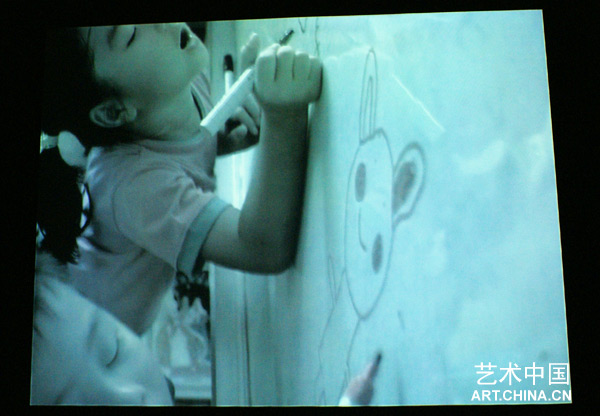|

台湾艺术家曾御钦生于1978年,毕业于台北艺术大学。视自己为实验电影制作者的曾御钦是台湾最新一代电影人的代表,他的许多电影作品能在网络上看到。在曾御钦的影像作品中,他描述了他那些角色的孤独。艺术家惯用的表现形式有时像是一种饱含折磨的、哀歌式的小型戏剧,在语言限制的边缘滑行。
有人认为曾御钦的艺术创作,不论是触及到记忆的发生或片段,整个创作的基调掌握表现出一种低调苦涩,以及欲语还休的心境。2007年曾御钦在卡塞尔文献展上展示的作品《有谁听见了》,描绘了几个孩子,他们头上被浇上了优酪乳,对着镜头露出笑容。他的作品使人想到了70、80年代台湾实验电影中洋溢着的浓郁的人文色彩。
这次,曾御钦带来的作品有双频录像作品《我痛恨假设》。两个相对的屏幕上播放着相似的画面——一辆大巴上坐满了像是刚刚放学的孩子,他们都闭着眼睛,随着清脆的背景音乐的节奏和汽车行驶的晃动轻轻地摇摆着身体。之所以会制作一件这样的作品,其感触来源于艺术家某个夜晚的突然惊醒。身旁睡的人到底是谁,猛然间好像完全没有了记忆,也一点都不熟悉。他想到,年少的时候坐在公车上,艳阳隔着玻璃窗投射在身上,车内冷气凉凉、懒懒的,不自觉地就闭上了眼,那种舒舒服服的感觉是多么让人难忘。因此,艺术家希望生命的过程是不是可以如此——闭上眼;不看,关上耳;不听,只留嘴去呼吸、肌肤去体验周遭冷暖。曾御钦的作品提出了一个值得深思的问题:在人与人之间,集体与个人之间,文明的传承与遗忘之间,如何找到一个人的位置和身份?

Taiwanese artist Tseng Yu-Chin was born in 1978 and graduated from the Taipei National University of the Arts. Seeing himself as a producer of experimental cinema, he is a representative of the latest generation of Taiwanese filmmakers, and many of his films are available on the internet. In his video works, he depicts the loneliness and solitude of his actors. His mode of expression is often ripe with torment and the rhetoric of martyrdom, turning his work into mournful short dramas that drift along the boundaries of language.
It has been said that Tseng Yu-Chin’s work, encompassing the fragments and recollections of memory, brings forth as its main chord a mellow bitterness that remains in the heart but can never be spoken. The piece he showed at Documenta XII in 2007, who is listening, depicts several children having milk poured over their heads while smiling at the lens. Such works recall the deeply humanistic atmospheric touches of Taiwanese experimental film from the 1970s and 1980s.

For this exhibition, Tseng Yu-Chin presents the dual channel video piece Assumption of I Hate Assumption. Similar images are projected on two facing screens: the scene is a schoolbus full of students straight out of class. All have their eyes closed, while their bodies gently rock to the rhythm of the background music and the motions of the bus. This vision feels as if it had struck the artist suddenly as he awoke from his sleep: who is this person sleeping next to me, and what happened to my memory? In that moment of confusion, he may have recalled a moment on the bus from his youth. The bright spring sun scatters across his skin through the window, the air conditioning is quiet but cool, and he involuntarily closes his eyes—that kind of comfort is difficult to forget. The artist hopes that life can remain in such a state: eyes shut, can’t see; ears closed, can’t hear; only the mouth continues to breathe while the skin senses the crispness of the air temperature. This work begs a question worthy of significant contemplation: between you and men, between collectivity and the individual, between history and oblivion, how can we located the position and identity of any particular person?


|

